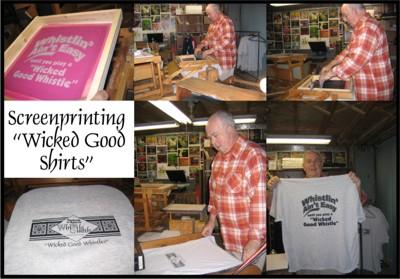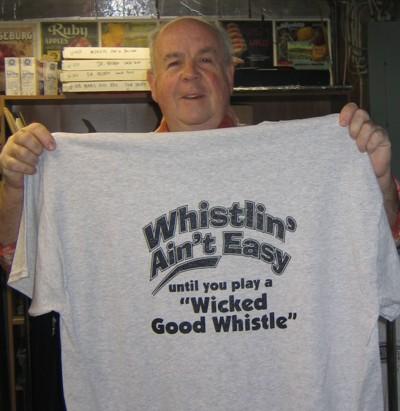Reviews and chat room discussions posted on the internet are prevalent and easy to find. The reviewers uses one or two whistles from a maker and try to make the playing attributes and physical appearance of those instruments clear to the reader. Using close up photography, material lists, and tuning descriptions obtained from electronic devices, the prospective buyer should have enough information to purchase a whistle that is perfect for their use. Because most whistles are made to last a lifetime, the buyer
need only buy the Magic Whistle once and be set for life. Right, Mary Jane?
Written music notation covers everything you need to know to play a piece of music as long as you can read the symbols and do the math. When you describe the sound of the Magic Whistle to another person, you use the same words describing the sound that you use to convey the complexities of food and drink. Rich, smooth, sharp, kind of flat, complex, dark, subtle undertones (i.e. flavors). and so on. When we run out of descriptive terms for food we add in air based terms like breathy, airy, breezy, and the infamous
(but not universally known) term of CHIFFY! Why all this descriptive chaos to describe the whistle and the sounds it makes? Here are some quotes I thought you might want to remember that came to me via e-mail.

“The whistle is a devilish hard thing to play. You can start at five and stay up all night and still not get it right. NOT EVER…and no one will ever know how you eventually made out unless you record it.” Paul C., Canada
“The whistle is magic and its sound is a transient traveler, leaving only a memory of the moment behind. Wow!, I just wrote that down… and had to send it to you!” Evelyn, Montana
” thought my new whistle was making a grunting sound, but then I discovered I was doing an Errol Garner kind of blues noise in my throat when I blew hard. Everything is under control now. Stay limber and keep on whistling. J.Carter, Texas
“after removing a piece of peanut, my whistle stopped playing two notes at a time. Maybe you should check the idea of a dual note playing whistle made on the Peanut Principal…on second thought, maybe not! Roy. M., Florida.
After having read more than a couple of hundred customer comments and twenty or so internet reviews over the past month, I have finally resolved whistle reviews are fun reading and let you view whistles not readily available, but there is also the danger of using out of date reviews to make important decisions on purchasing your new Magic Whistle.
Not so quick! Reviews posted on the internet and comments made on chat rooms while discussing various whistles stay active forever unless the writer deletes the post or replaces the information with a new, up to date article. Meanwhile, many months, even years have passed and the maker of the instrument may have completely changed or improved the design. Since most whistle makers work on improvements trying to find the Magic Whistle all the time, the appearance of the whistle has probably changed and materials
may have been upgraded and changed since the review was written. Even worse, the maker may be out of business, deceased or given up whistle making entirely months before. However, the reader of these postings is still basing their opinions on buying a Magic Whistle from the maker on invalid information that is out of date.
The answer to the problem of sorting all this information out is really very simple! Using cut and paste on your computer, copy the information to your clipboard and then paste the review into your e-mail. Send the e-mail to the manufacturer of the whistle and ask if the problems in the article have been taken care of. Be sure to tell the company you are a prospective buyer and other pertinent information so they will know you are serious and not some spamer trying to bust their website. I be you get an honest
answer in a hurry…and you will know whats going on from the source that makes the whistle your are interested in.
Every new whistle maker is excited about having made an inanimate piece of wood or pipe turn into a Magic Whistle. They hurry to show everyone their new and unique Magic Whistle and immediately think it is ready for marketing and review. I know that my granddaughter Marilyn and I though our very first whistle was perfect when it was born. When it played, we both thought it was the most miraculous thing we had ever heard. The first whistle is hanging in the shop today as a reminder that it wasn’t so perfect and
several hundred changes have happened along the way since we first made it. Have we made the Magic Whistle? Not yet! But, we spend a lot of effort every week trying to pump some more magic into every instrument we make.
I believe one of the most remarkable aspects of making whistles is the fact that people everywhere are interested in what you are doing. I have spent over forty five plus years doing custom artwork and complicated projects for folks and I have never experienced a more interested group of people than whistlers. They are tolerant, educated, have definite opinions, likes and dislikes and most of all enjoy talking about everything pertaining to whistles. Whistler players and collectors are not cheap folks! If they
determine there is a Magic Whistle available, no amount of cash will deter them from bidding, buying or obtaining it by trading their valuables for it.
So let’s get it right and lay all that debate about good whistles and bad whistles and cheap whistles and expensive whistles to rest. If you take all the material in the best whistle made and add it up you won’t break a $20. bill. If you take all the material in the cheapest whistle in the market place you should have about a $1. or less.
So what makes a whistle worth all those big bucks to a prospective buyer? You will probably say exotic wood, silver, gold, brass or all the hours crafting a nice sounding INSTRUMENT. Calling a whistle an instrument makes the humble whistle sound much more grand! It’s the same trick they use on Antiques Roadshow when the appraiser calls your junk a very nice Piece. You may also consider the brand name, trademark, makers reputation, and of course the all important Model Name! Join all these items together and you
will be sure you are going to finally receive the elusive Magic Whistle! Well, there is no Magic Whistle, Mary Jane!
Suppose all the Whistle categories were changed so buyers can better understand what the whistle they are purchasing is made for.
Category One: Souvenir Whistles
are remembrances of where you have vacationed and bought a whistle. They are a souvenir of where you have been and had a good time and should be displayed and admired for their appearance and where they came from. They would fall into the category of tee shirts, tea cups, carved fish and other wonders we bring back from vacation. The only excuse for not having several Souvenir Whistles from your vacation would be a hangover, hangnail from shopping too hard or the vacation turned out to be a flop due to
hurricane, cyclone, or tropical storm. These whistles should be inexpensive so everyone back home can receive one without breaking the budget, because we all know how inflation has wrecked travel costs and inflated the cost of souvenir purchasing.
Category Two: Real Playable Whistles which are made for playing music. The whistle has to be in tune through a couple of octaves, show good workmanship and be made from materials suitable for whistles. No pelican bone mouthpieces or ox bone ferrules here! Real Playable Whistles would be reasonably priced, carry a warranty on parts, and of course play without unusual fingerings or unreasonable breath requirements. Most folks will want a Real Playable Whistle because they are a Real Good
Deal!
Category Three: Whistles Good enough for a Beginner! This of course would be the very best and most expensive whistle available, because everyone knows a beginner needs to have a great experience starting out. Pricing could run up the price scale a bit, or a bit more if the beginner is desperate enough to get the whistle without waiting. Tuning, finish, reach and air requirements should be top notch. Playing this whistle should be effortless. No hanky panky and unusual breath control
requirements for this instrument. This whistle has to be “Good enough for a Beginner” so tuning is perfect through two full octaves and into the third, no chiff unless asked for, effortless changes up and down between octaves and breath requirements held to minimal. Best of all there is no practice necessary to play this whistle with fabulous speed and computer like precision because it has been forged for a Beginner. This whistle must come close to being a Magic Whistle or it has to be exchanged within a thirty
day period and be replaced with a more suitable brand and model of whistle to avoid disturbance in the Force. May the Force be with You!
The Magic Whistle is in its own category. Just leave it there and go off and search for a whistle that makes you happy when you play. To give you a start, I leave you with the following ways you might find what you are looking for and several facts about the Search for the Magic Whistle that you may have overlooked.
Some folks think the answer to getting a Magic Whistle is to buy a crate of inexpensive whistles and sort them out until you find one that plays in a Magical Manner. No matter how much time and money spent it will be worth the effort…Sorry you still end up with a cheaply made whistle that plays well and cost a lot of money to obtain. If you use this method of obtaining you whistles, you should become a dealer or better yet, a distributor of whistles.
Or you can buy a Magic Whistle that has been forced into being playable by a professional tweaker somewhere out there. Now you have a whistle that has been remade into something playable and you have paid a premium price for a whistle that plays. Remember the resale market for an altered whistle is non-existent so you really have a one of a kind instrument. If tweakers are good at making other makers whistles play, they should apply for a job in the whistle factory as an engineer or invention improver and make
some big bucks for their time. Why waste all that time and effort promoting someone else’s whistle brand when the Magic is yours? Why not start a new brand and market a new and innovative whistle that really plays and call it the Magic Whistle? The world is waiting for your product.
Little Known Facts about Whistling:
The Magic Whistle will make you happy! The sign of a happy person is someone who whistles while they work. Whistling lets you pass the time while doing all those tedious chores and tells the world you find enjoyment in what you are doing. Playing for a while every day with your Magic whistle will make you happy and healthy at the same time.
The Magic Whistle is medicinal! Your lung power and capacity increase with every hour you play. A good Low Whistle should bring you up to the capacity to inflate a truck tire with a single breath in about a month. My doctor was amazed at my lung capacity and when I said it was probably from playing whistle all the time, she muttered something that sounded like “I’m more inclined to believe it might be genetically inherited long windedness”. Anyway, you will have more breathing capacity the more and longer you
play and that is a bit if magic in it’s self.
Playing your Magic Whistle gives your hands and fingers a good workout and improves your flexibility. If you keep time with your feet,(and I confess I keep time with both feet) then you get a bit of a double workout. If stiffness and a touch of the old arthritis in the joints is bothering, a good session on the whistle helps keep you limber and improves your sense of well being.
The Magic whistle will improve your mind. Music is like a crossword puzzle for your mind and learning a new piece of music is good for you. A new tune or two will give you an enjoyable and entertaining way to keep alert and active. Take your whistle with you everywhere, play every time you get a chance and expand your ability to play a larger variety of music.
It is amazing the friends you make with a Magic Whistle! Playing the whistle lets folks know you are a happy person and they in turn will be happily listening to your music. Everyone loves the whistle and whistle music because they hear music they are familiar with. Perhaps, they played the whistle , ocarina, recorder or Tonette and remember how much fun it was.
Listeners will also be appreciative of your playing regardless of what kind of music you play. Take your whistle and play it everywhere and anytime you have a chance. The best complement I ever received came from a fisherman on a bridge in the Florida Keys. He listened to me wailing away on my whistle while waiting for a fish to bite and when I finished said, “Sounds just like Jethro Tull” Wow! I was just blown away by that one.
If you need a hobby, finding the Magic Whistle should keep you busy for your entire lifetime. I think that’s what my granddaughter Marilyn meant when she and I were discussing whistles after supper one night. “You know Gramp, If you don’t sell all these whistles you are making, you will have the largest collection of whistles in the world!” You have to admit, that is a very interesting concept and probably has a good amount of truth to it.
Things you should remember before leaving on your Quest for the Magic Whistle. Don’t be discouraged or dissuaded from your Quest by anything. Search in all directions and listen to the advise of strangers about every whistle related rumor and sighting of the existence of a Magic Whistle. Acquire as many varieties of whistles that hold magic and play them all to see if you can acquire the essence they may hold. Spend a dragon’s ransom and acquire a hoard! Sell, buy and dispose of your
hoard with others only after advising them that they are getting possession only because you have more Magic than you can handle and are willing to share your wealth with others in search of the Magic Whistle.
And if all fails in your Quest for the Magic Whistle… You might consider purchasing a Wicked Good Whistle that has a lot of handmade magic. Lots of good models and keys and at a price you can afford. In fact, your can afford two at the price they’re going for and still have enough left over for a burger and fries on your way home. Super size and get the Low D to go!



 If you have read the article on Kevin’s Whistle you will remember I have been working on a
If you have read the article on Kevin’s Whistle you will remember I have been working on a 





